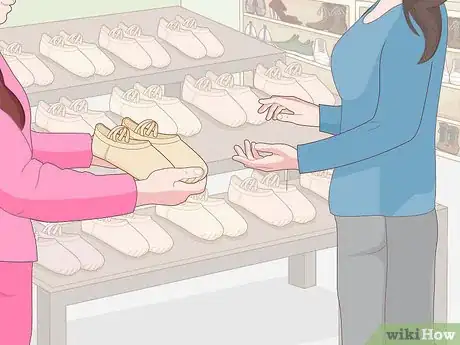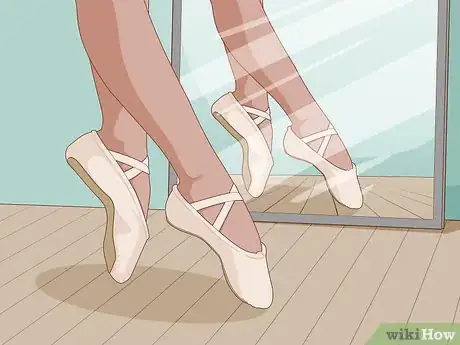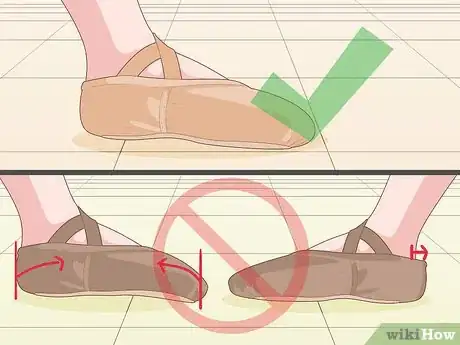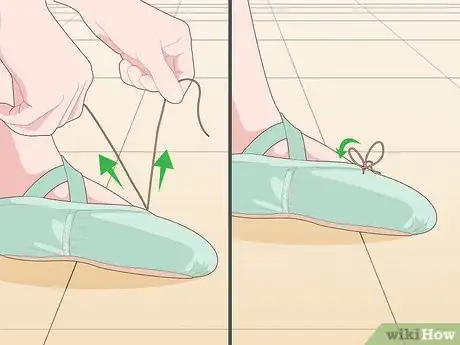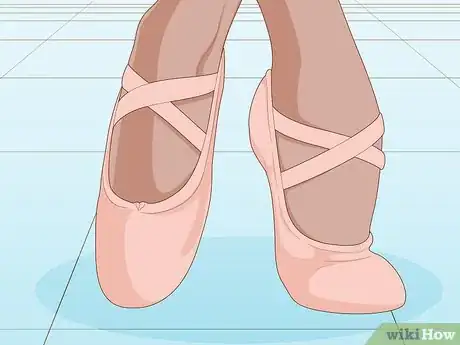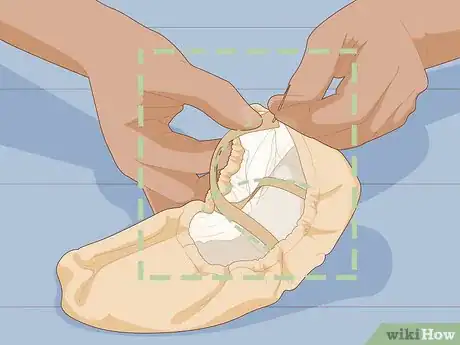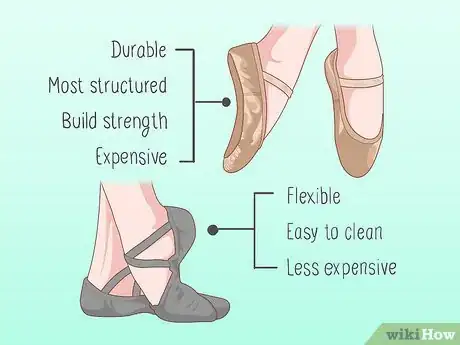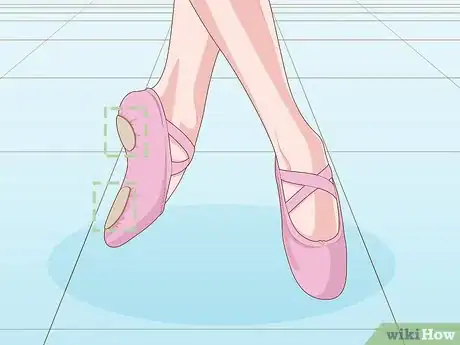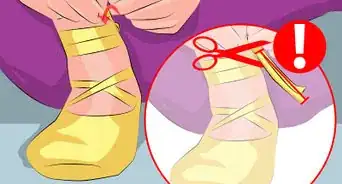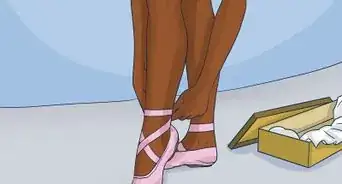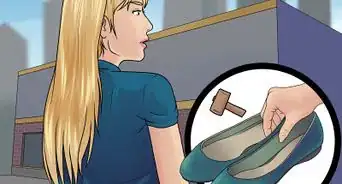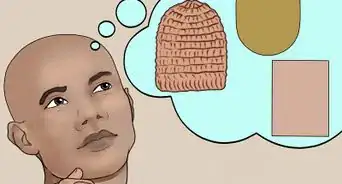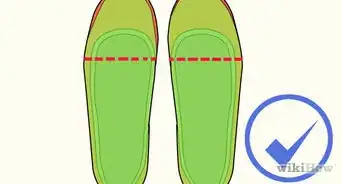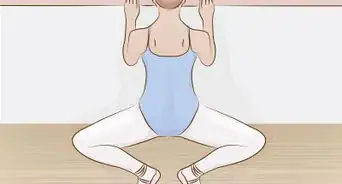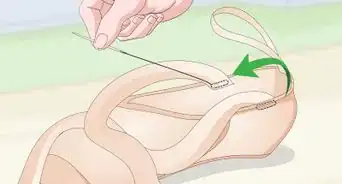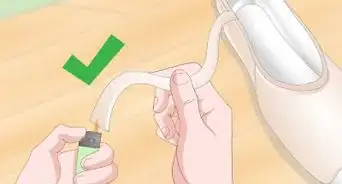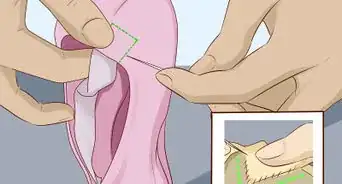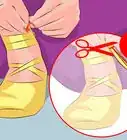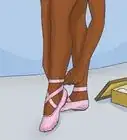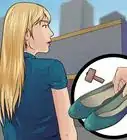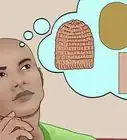This article was co-authored by Geraldine Grace Johns. Geraldine Grace Johns is a Professional Ballerina and the Owner of Grace Ballet in New York and Los Angeles. Geraldine toured through New Zealand, Australia, Japan, and Korea as Jammes in Ken Hill's Original Phantom of the Opera. She has studied with the Royal Academy of Dance in London to become a teacher and taught for the Kudo School of Ballet in Yokohama. Geraldine also ran her own Royal Academy of Dance School in New Zealand before studying at the Neighborhood Playhouse School of the Theatre in New York City. Geraldine was a guest coach and Master Class teacher in Toronto for the Canadian Royal Academy of Dance's Dance Challenge in 2018, 2019, and 2020. She was also a guest coach and Master Class teacher for the USA Royal Academy of Dance Challenge in Long Beach, California in 2019 and 2020. Grace Ballet Los Angeles has won recognition as one of 13 Best Ballet Schools in Los Angeles since opening her school. Geraldine is a contract Practical Teaching Supervisor for the Certificate in Ballet Teaching Studies for the Royal Academy of Dance.
This article has been viewed 46,551 times.
Whether you’re new to ballet or an experienced dancer looking for a better-fitting shoe, there are several measures you can take to ensure a perfect fit. Soft ballet shoes are made from either canvas or leather, and they do not have the hard, structured parts that pointe shoes have. Make sure that your soft ballet shoes fit properly by trying them on and looking at how they conform to your feet. You'll also select the material and style of shoe that suits you best, and adjust the fit if necessary.
Steps
Choosing Soft Ballet Shoes That Fit Properly
-
1Visit a dance supply store for help choosing shoes. Go to a dance supply store to try on different types of shoes (and get help from the professionals who work there, if you need it.) Consulting someone who knows how ballet shoes should fit will help to ensure that your shoes are comfortable and well-suited to your needs.[1] [2]
- You can also ask your dance instructor. They can advise you on the best type of shoe and fit.
Tip: If you have never worn soft ballet shoes before, avoid ordering them online. You can reorder the same shoes once you know what your size it, but it’s best to buy the first pair in person.
-
2Try on a pair of ballet shoes in your size and stand up in them. The best way to fit soft ballet shoes is to select a pair that you like in the size that you think you will need and try them on. Stand up in the shoes, preferably in front of a mirror so you can easily see your feet from the sides.
- Ballet shoe sizes vary by manufacturer, so you may need to consult the manufacturer’s size chart to find the best size ballet shoe for you.[3]
- Make sure to put on the shoes over the tights or socks that you normally wear for dancing.
Advertisement -
3Note how the shoes look and feel on your feet. Soft ballet shoes should fit your feet in a way that feels snug yet comfortable, almost like socks. They should not be so loose that they look baggy, or so tight that you cannot stand with your feet flat on the ground. If there's excess material around the toe or heel, then the shoes are too loose. If you cannot straighten out your big toe while standing in the shoes, then the shoes are too tight.[4]
- Go up to the next half size if the shoes are too tight on you, or go down to the next half size if they are too loose.
Adjusting the Fit of the Shoes
-
1Adjust the drawstring until the shoe feels comfortable on your foot. With the shoe on your foot, locate the drawstring on the inside of the shoe near the toe. Grasp both ends of the drawstring and pull it until it feels comfortable on your foot. Tie the drawstring in a bow or a double knot when you are happy with the fit. Then, tuck in the bow or knot so it is hidden.[5]
- Repeat this for the other shoe.
Tip: Some shoes have elastic sewn into the opening and no drawstrings, so you may not need to adjust a drawstring. A shoe with an elastic sewn into the opening will conform to your foot without any adjustment.[6]
-
2Get shoes with elastic straps already sewn in for a standard fit. You can purchase soft ballet shoes that have 1 or 2 elastic straps already sewn into the shoes. The elastic straps go across the top of your foot to help keep the shoes secure while you dance. Choose a pair with elastic straps that feel comfortable when you try them on.[7]
- If the elastic straps feel too tight, or too loose, then you may want to opt for a different size.
-
3Sew in the elastic straps yourself for a custom fit. Many ballet dancers sew in their own elastic straps to get a custom fit. Choose a pair of soft ballet shoes without elastic straps and then choose elastic that matches the shoes. Position the elastic straps so that they criss-cross over the top of your foot, and then use a needle and thread to hand-sew the ends of the elastic straps into the inside of the shoes near the heels and along the sides of your feet near the toes.[8] [9]
- Ballet shoes with elastics not already sewn into them may come with the elastic straps and instructions for how to attach them, or you may need to purchase the elastic separately.
Selecting the Shoe Material and Style
-
1Opt for leather shoes for more resistance or canvas for more flexibility. Leather ballet shoes are more structured, so they can help you to build strength in your feet, ankles, and calves. Leather shoes are also more durable and last longer, but they can be expensive. Canvas ballet shoes provide more flexibility, are easier to clean, and they are less expensive than leather ballet shoes.[10]
Tip: Since leather shoes last longer and provide resistance and canvas shoes allow more flexibility, some dancers practice in their leather shoes and save their canvas shoes for performances.
-
2Choose full-soled ballet shoes for more resistance. Full-soled shoes have a sole that goes all the way from the heel to the toe. A full-soled shoe provides more structure, so these are often recommended for younger dancers, but some adults prefer them as well.[11]
- Keep in mind that it will be harder to use your full range of motion with full-soled shoes, so some moves may be harder to execute, such as pointing your toes.
-
3Go with a split-soled ballet shoe for a wider range of motion. Split-soled shoes have 2 separate soles on the bottom of each shoe. One part of the sole is under the heel and the other part is under the ball of your foot, which leaves the arch of your foot open. Adult dancers usually opt for split-soled shoes.[12]
- A split-soled ballet shoe offers less support for your feet, but it makes it easier to move your feet in ways that a full-soled shoe might not.
Expert Q&A
-
QuestionHow do I know what size ballet shoes to get?
 Geraldine Grace JohnsGeraldine Grace Johns is a Professional Ballerina and the Owner of Grace Ballet in New York and Los Angeles. Geraldine toured through New Zealand, Australia, Japan, and Korea as Jammes in Ken Hill's Original Phantom of the Opera. She has studied with the Royal Academy of Dance in London to become a teacher and taught for the Kudo School of Ballet in Yokohama. Geraldine also ran her own Royal Academy of Dance School in New Zealand before studying at the Neighborhood Playhouse School of the Theatre in New York City. Geraldine was a guest coach and Master Class teacher in Toronto for the Canadian Royal Academy of Dance's Dance Challenge in 2018, 2019, and 2020. She was also a guest coach and Master Class teacher for the USA Royal Academy of Dance Challenge in Long Beach, California in 2019 and 2020. Grace Ballet Los Angeles has won recognition as one of 13 Best Ballet Schools in Los Angeles since opening her school. Geraldine is a contract Practical Teaching Supervisor for the Certificate in Ballet Teaching Studies for the Royal Academy of Dance.
Geraldine Grace JohnsGeraldine Grace Johns is a Professional Ballerina and the Owner of Grace Ballet in New York and Los Angeles. Geraldine toured through New Zealand, Australia, Japan, and Korea as Jammes in Ken Hill's Original Phantom of the Opera. She has studied with the Royal Academy of Dance in London to become a teacher and taught for the Kudo School of Ballet in Yokohama. Geraldine also ran her own Royal Academy of Dance School in New Zealand before studying at the Neighborhood Playhouse School of the Theatre in New York City. Geraldine was a guest coach and Master Class teacher in Toronto for the Canadian Royal Academy of Dance's Dance Challenge in 2018, 2019, and 2020. She was also a guest coach and Master Class teacher for the USA Royal Academy of Dance Challenge in Long Beach, California in 2019 and 2020. Grace Ballet Los Angeles has won recognition as one of 13 Best Ballet Schools in Los Angeles since opening her school. Geraldine is a contract Practical Teaching Supervisor for the Certificate in Ballet Teaching Studies for the Royal Academy of Dance.
Professional Ballerina & Ballet Instructor Go to a professional ballet shop to get fitted for your first pair of ballet shoes to ensure they're properly sized for your feet.
Go to a professional ballet shop to get fitted for your first pair of ballet shoes to ensure they're properly sized for your feet. -
QuestionWhy can't I use rubbing alcohol on my canvas shoes?
 Community AnswerUsing rubbing alcohol on canvas ballet shoes will damage and discolor the material.
Community AnswerUsing rubbing alcohol on canvas ballet shoes will damage and discolor the material. -
QuestionOn a canvas shoe, should the toe pad be under the toe?
 MORIAH ROSSCommunity AnswerThe toe pad would be around the toe, but not under it exactly. It would be under the majority of the ball of the foot but not the tips of your toes.
MORIAH ROSSCommunity AnswerThe toe pad would be around the toe, but not under it exactly. It would be under the majority of the ball of the foot but not the tips of your toes.
References
- ↑ Geraldine Grace Johns. Professional Ballerina & Ballet Instructor. Expert Interview. 11 November 2020.
- ↑ https://www.pointemagazine.com/pointe-shoe-fitting-2412887873.html
- ↑ https://www.dancesupplies.com/sizing/bloch-shoe-sizing-chart.pdf
- ↑ https://www.businessinsider.com/best-ballet-shoes
- ↑ https://www.youtube.com/watch?v=NFWtuXdTOeU&feature=youtu.be&t=40
- ↑ https://www.businessinsider.com/best-ballet-shoes
- ↑ https://www.businessinsider.com/best-ballet-shoes
- ↑ Geraldine Grace Johns. Professional Ballerina & Ballet Instructor. Expert Interview. 11 November 2020.
- ↑ https://www.businessinsider.com/best-ballet-shoes
